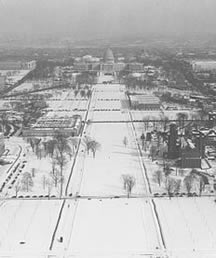
Washington, D.C.
Elms of the National Mall
National Mall, 1936. Courtesy National Park Service.
history (Jefferson American Elm)
First envisioned by Pierre Charles L’Enfant in his original 1791 design for the city of Washington, the National Mall ranks amongst the most important and easily recognizable expanses of green space in the United States. L’Enfant's vision was that of a “Grand Avenue,” approximately one mile long and 400 feet wide, lined with trees and bordered by gardens, Federal buildings, and the houses of diplomats. However, the sweeping public parkland that occupies the National Mall today is largely a product of the 1901 McMillan Commission. Chaired by Michigan Senator James McMillan, the Commission consisted of Daniel H. Burnham, director of the World’s Columbian Exposition held in Chicago in 1893; landscape architect Frederick Law Olmsted, Jr.; architect Charles F. McKim; and sculptor Augustus Saint-Gaudens. The Commission envisioned a return to L’Enfant’s “Grand Avenue,” calling for an open, grassy vista leading to the Capitol, flanked by four rows of American elm trees on either side. The Commission explained that “The American elm was chosen not only because of the architectural character of its columnar trunk and the delicate traceries formed by its wide-spreading branches, but also because in the District of Columbia this tree is at its best, notable examples being found in the city parks and in the grounds of the Capitol.” While the Commission made major strides in beautifying the space, the siting of temporary military structures on the Mall during World War I meant little progress was made in the initial tree plantings until the 1920s.
In 1934, the jurisdiction of the Mall’s numerous parcels was consolidated under the National Park Service, with the entire expanse managed as a single unit for the first time. By 1936, the north and south borders of the Mall were planted with more than 300 American Elms in four parallel rows. The tree now known as the National Mall Jefferson American Elm was among these, purchased from the Connecticut-based Leissler’s Nursery, and was likely planted sometime during the summer of 1935. In total, some 600 American elms were planted on Mall in the 1930s. Although many of the original American elms planted during that time have since died and been replaced, the National Mall Jefferson Elm and its few fellow surviving trees recall the time when L’Enfant’s vision was finally realized, nearly one-and-a-half centuries after its creation, by the McMillan Commission.